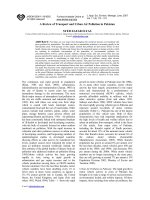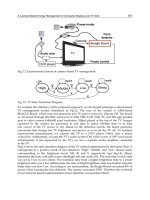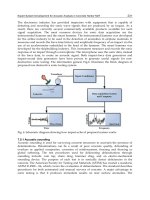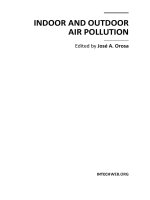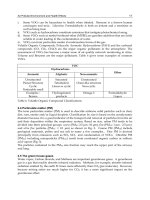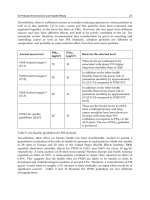Indoor and Outdoor Air Pollution Part 9 ppt
Bạn đang xem bản rút gọn của tài liệu. Xem và tải ngay bản đầy đủ của tài liệu tại đây (584.78 KB, 10 trang )
Spectroscopy Analysis of Corrosion in the Electronic Industry
Influenced by Santa Ana Winds in Marine Environments of Mexico
71
more dark sections without chloride ions, compared with the evaluation in Ensenada. Auger
spectra indicate the air pollutants combined with CO
2
of the environment (Figure 5b). Table
4 represents the atomic concentration of metallic probes with the percentages of air
pollutants and carbon and oxygen (Sankara et al, 2007, Clark, 2006).
(a) (b)
Fig. 4. Analysis of corrosion products of copper at one year of exposition: (a) Auger map and
(b) AES in Ensenada (2010).
(a) (b)
Fig. 5. Analysis of corrosion products of copper at one year of exposition: (a) Auger map and
(b) AES in Tijuana (2010).
Indoor and Outdoor Air Pollution
72
Figures 6 and 7 show the Auger spectra at 1, 3 and 6 months of metallic coupons, after the
cleaning process with Ar
+
ions, at 5 minutes. SEM and AES analyses were carried out to
determine the corrosion products formed in the copper surface. Figures 6 and 7show the
scanning electron micrograph (SEM) images of areas selected for AES analysis covered by the
principal corrosion products which are rich in the both air pollutants mentioned above in both
cities as the test results indicate. The Auger map process was performed to analyze punctual
zones, indicating the presence of Cl
-
and S
=
as the main corrosive ions present in the copper
corrosion products. The Auger spectra of Cu specimens was generated using a 5keV electron
beam, which shows an analysis the chemical composition of the thin films formed in the Cu
surface in Ensenada (Fig 2) and in Tijuana (Fig 3). The AES spectra of copper specimens
installed in industrial plants in both cities show the surface analysis of three points evaluated
in different zones of the metallic probes. The peaks of Cu appear between 905 and 915 eV,
finding the chlorides and sulphides. In figure 6, the spectra reveals the presence of carbon
and oxygen, chlorides and sulphides, with variable concentration in the chemical composition
in the three regions analyzed, where the principal pollutant was Cl
-
ion.
Ensenada TIJUANA
Elements Point 1 Point 2 Point 3 Point 1 Point 2 Point 3
C 36 29 29 24 26 23
Cl 12 32 31 X X X
Cu 13 11 12 19 21 26
O 8 12 13 26 23 19
S 31 16 15 31 30 32
Table 4. Atomic concentration (%) of metallic probes.
Fig. 6. Depth profile analysis in copper surface, Ensenada (2010).
Spectroscopy Analysis of Corrosion in the Electronic Industry
Influenced by Santa Ana Winds in Marine Environments of Mexico
73
Fig. 7. Depth profile analysis in copper surface, Mexicali (2010).
The spectra reveal the importance of technical analysis with the Auger, which is evaluated
with the formation of the films formed on copper surface thereby know the mechanism of
corrosion in this metal. Auger depth profiles were collected on specimens of both cities,
showed in figures 6 and 7. The depth profiling technique is defined by alternating cycles of
Ar
+
-ion sputtering to remove a thin layer (5 to 10 Ǻ) of air pollutants that react with the
copper surface and their characterization in some regions with the AES technique. In figures
6 and 7, chloride and sulfur located between carbide particles sputtered completely off
during the first sputtering cycle (10 Ǻ). A small chloride and sulphide persisted deeper into
the carbide particles (point 2). In figure 6, the depth profile indicates a small presence of
sulfur between the carbide particles.
4. Discussion
The air pollutants affect the deterioration of copper and its corrosion behavior and
resistance. The principal anthropogenic and natural sources in indoor of industrial plants in
both cities of corrosive pollutants are the gas emissions of vehicles, chloride particles from
the marine environment and sulfides from the thermoelectrical power plants in Tijuana,
Rosarito and Ensenada. Generation of corrosion in industrial plants has been an important
factor in the last 30 years by the complexity of the electro-electronic devices and equipments
that are qualified by the market demand, their operation and reliability (Lopez et al, 2007).
The competition is governed by manufacture of electronic devices and equipments,
increasing the necessity of develop various and great quantity of operations and decrease
their size at a low cost (Valdez at al, 2006). This been has the principal effect to change the
designs with smaller spaces between electronic devices and the use of new materials in
electrical connectors and connections of electronic devices and equipments. Other factors are
the uncontrolled climates of indoors, that promote the generation of corrosion (Lopez, 2008).
Indoor and Outdoor Air Pollution
74
In most cases companies do not know the phenomenon of corrosion or not are considered as
an important factor, until it causes a failure in some electronic devices and equipments, and
stop the manufacture process.
5. Conclusion
Miniaturization and the requirement for high component density of small electronic devices
need closer spacing and thinner metallic paths affected by corrosion and electrical failures.
Copper exposed to air pollutants reveal that an increase on their concentrations at outdoor
conditions has a critical impact on the indoor corrosion process in arid and marine
environments. RH values higher than 75 % and concentration of air pollutants, promotes
corrosion. The composition of the copper surface was obtained by the Auger spectra,
showing localized corrosion from the first month to six months of exposure in both cities,
and uniform corrosion. Particulate and gaseous pollutants, deposited on metal surfaces of
micro-electronic components, are generated at residential and industrial zones with high
motor traffic and operations in warehouses and offices, which promote corrosion. Electronic
equipment installed in industrial plants are exposed to environmental factors in indoor and
outdoor conditions. The corrosion of copper in indoor environments may be viewed as a
variation of outdoor atmospheric corrosion. In contrast to outdoor exposure, in an indoor
environment the wet film on the metal surface is thinner and it is often governed by
relatively constant controlled humidity conditions. Sometimes the indoor environment
temperature and RH are controlled and as a consequence, the amount of adsorbed water on
surfaces is minimal and is constrained within reasonably tight limits. Currently measuring
equipment such surface analysis techniques as AES was used in most of the industrial
processes are very used to detect particles added to the metallic surfaces. In this study,
Auger spectroscopy was made to detect the principal components added to surface of
electrical connections and connectors. With this techniques, can obtain results of the
chemical reaction the atmospheric agents that forms the thin films in metals of copper.
Miniaturization and the requirement for high component density of small electronic devices
need closer spacing and thinner metallic paths that originates the corrosion phenomena and
electrical failures in the connections. Uniform and localized corrosion mechanisms are
detected in electronic systems. Particulate and gaseous pollutants deposited on metal
surfaces of micro-electronic components generated by traffic vehicles and operations of
thermo electrical located at 50 kms of each city and provide electricity to this region in
warehouses and offices, and promote corrosion. Electronic equipments installed in
industrial plants are exposed to environmental factors, indoor and outdoor.
6. Acknowledgments
The authors express their gratitude for the financial support, of a Postdoctoral Scholarship
to Gustavo Lopez by the Consejo Nacional de Ciencia y Tecnologia, trough Centro de
Investigacion y de Educacion Superior de Ensenada and Universidad Nacional Autonoma
de Mexico in Ensenada.
7. References
Annual Book of ASTM Standards, 2000, Wear and Erosion: Metal Corrosion, Vol. 03.02.
ASHRAE; Handbook; Heating, Ventilating and Ari-Conditioning; applications; American
Society of Heating, Refrigerating and Air-Conditioning Engineers Inc.; 1999.
Spectroscopy Analysis of Corrosion in the Electronic Industry
Influenced by Santa Ana Winds in Marine Environments of Mexico
75
Asami K., Kikuchi M. and Hashimoto K.; An auger electron spectroscopic study of the
corrosion behavior of an amorphous Zr
40
Cu
60
alloy; Corrosion Science; Volume 39,
Issue 1, January 1997, Pages 95-106; 1997.
Briggs D. and Seah M. P., Practical surface analysis, Second Edition, Volume 1 Auger and
XPS, Photoelectron Spectroscopy,1990.
Clark A. E., Pantan C. G, Hench L. L; Auger Spectroscopic Analysis of Bioglass Corrosion
Films; Journal of the American Ceramic Society; Volume 59 Issue 1-2, Pages 37–39;
2006.
Cole S. and Paterson D. A.; Relation of atmospheric pollution and the generation of
corrosion in metals of copper, steel and nickel; Corrosion Engineering; 2004.
Consejo Nacional de Poblacion (CNP), Anuario Estadistico, Censo de Poblacion, Gobierno
de Mexico, 2010.
Dillon P., MTI & DOE Launch Project Partnerships, Communications Materials Technology
Institute of the Chemical Process Industries, Inc, 2000.
Duncan Balachandran, Walsh Harold; An Engineer's Guide to MATLAB, 2e: with
Applications Electrical Systems, ; Prentice Hall, 2005. ISO 9223:1992, Corrosion of
metals and alloys, Corrosivity of Atmospheres, Classification. ISO 11844-2:2005.
Corrosion of metals and alloys - Classification of low corrosivity of indoor
atmospheres - Determination and estimation attack in indoor atmospheres. ISO,
Geneva, 2005. ISO 11844-1:2006. Corrosion of metals and alloys - Classification of
low corrosivity of indoor atmospheres- Determination and estimation of indoor
corrosivity. ISO, Geneva, 2006.
Lopez B.G.; Ph.D. Thesis; Caracterización de la corrosión en materiales metálicos de la
industria electrónica en Mexicali, B.C., 2008 (Spanish).
Lopez B.G., Valdez S.B., Zlatev K.R., Flores P.J., Carrillo B.M. and Schorr W. M.; Corrosion of
metals at indoor conditions in the electronics manufacturing industry; Anti-
Corrosion Methods and Materials; 2007.
Lopez B. G., Valdez S. B., Schorr W. M., Tiznado V. H., Soto H. G., Influence of climate
factors on copper corrosion in electronic equipments and devices, Anti-Corrosion
Methods and Materials; 2010.
Lopez G., Tiznado H., Soto G., De la Cruz W., Valdez B., Schorr M., Zlatev R.; “Corrosion de
dispositivos electronicos por contaminacion atmosferica en intertiores de plantas de
ambientes aridos y marinos; Nova Scientia, ISSN 2007-0705; 2010 (in Spanish).
Lopez B. Gustavo, Valdez S. Benjamin, Schorr W. Miguel, Zlatev R., Tiznado V. Hugo, Soto
H. Gerardo, De la Cruz W.; AES in corrosion of electronic devices in arid in marine
environments; AntiCorrosion Methods and Materials; (in press).
Moncmanova A. Ed. ; Environmental Deterioration of Materials, WITPress, 2007, pp 108-
112.
Sankara Narayanan, Young Woo Park and Kang Yong Lee, Science direct, Elsevier B.V,
“Fretting-corrosion mapping of tin-plated copper alloy contacts”, Volume 262,
Issues 1-2, 4 January 2007, Pag 228-233.
Swart H.C., Terblans J.J., Coetsee E., Kumar V., Ntwaeaborwa O.M.,Dhlamini M.S., Dolo J.J.,
Auger electron spectroscopy and X-ray photoelectron spectroscopy study of the
electron-stimulated surface chemical reaction mechanism for phosphor
degradation, Surface and Interface Analysis, Accesed:
2010.
Indoor and Outdoor Air Pollution
76
Traviña A., Ortiz-Figueroa M., Cosio M.; Santa Ana winds and upwelling filaments off the
Northern Baja California winds; Journal of Dynamic of Atmospheres and Oceans;
2002 .
Valdez B. and Schorr M.; El control de la corrosión en la industria electrónica; Revista
Ciencia; 2006 (Spanish).
Veleva L., Valdez B., Lopez G., Vargas L. and Flores J.; Atmospheric corrosion of electro-
electronics metals in urban desert simulated indoor environment; Corrosion
Engineering Science and Technology; 2008.
Yves Van Ingelgem
*
, Isabelle Vandendael, Jean Vereecken, Annick Hubin, Study of copper
corrosion products formed during localized corrosion using field emission Auger
electron spectroscopy, Surface and Interface Analysis, Volume 40 Issue 3-
4, Pages 273 –276, 2008.
Zlatev R., Valdez B., Stoycheva M., Vargas L., Lopez G., Schorr M.; Simpsoium 16: NACE
“Corrosion and Metallurgy”; IMRC 2009, Cancun, Mexico.
Part 2
Indoor Air Quality
5
Correlation of Professional Performance
to Acceptable IAQ in Critical Care
Medical Facilities
H.W. Holder
1
, K.V. Easterwood, Jr.
2
, D.E. Johnson
3
,
J.W. Sealy
4
, M.D.Larranaga
5
and D.C. Straus
6
1
SWK LLC
2
Legacy Consulting, LLC
3
SWK LLC
4
Jim Sealy, Architect Consultant
5
Oklahoma State University
6
Texas Tech University Health Sciences Center
USA
1. Introduction
Fundamentally, buildings are simple things. Its basic purpose is to provide shelter. Initially,
caves, cow hides for tents, hay for roofs, and mud for walls fulfilled this function. As life
became more complex, beyond looking for the next meal, buildings followed suit.
Historically, humanity has evolved from utilizing natural materials and living with the
inherent limitations of these materials to integrating manufactured products limited only by
the imagination of the designer. But if form truly “follows function”
1
there is possibly no
more of a complex and critical function than that of our critical care medical facilities. These
functions are so critical that, for the most part, a team of specialists is required to provide a
fully operational facility. The realization of a building from a building program (written
statement of need) into a three dimensional form is typically “chaired” by the architect who
similarly employs the talents of various engineers and other specialists. All of this talent
demands, and deserves, a fee structure higher than what is typically seen for office and
other commercial buildings. Yet, even with the skill levels in place to bring such a complex
environment together, flawed and defective buildings are designed and constructed. The
ramifications of unsuccessful hospitals impact the very purpose of its mission and impose
unnecessary burden on staff and management, but more significantly: Defective Buildings
shorten the life of buildings and defective critical care medical buildings present serious
health and safety risks to patients and staff.
1
"It is the pervading law of all things organic, and inorganic, of all things physical and metaphysical, of
all things human and all things super-human, of all true manifestations of the head, of the heart, of the
soul, that the life is recognizable in its expression, that form ever follows function. This is the law.
"American architect, Louis Sullivan, (1856-1924)
Indoor and Outdoor Air Pollution
80
Various sub-systems that comprise the whole building (thus making the building a system)
include, but are not limited to, the roof, walls and fenestration, heating, ventilation and air-
conditioning system (HVAC), plumbing, electrical, finishes, furnishings, equipment and
communication systems. At present, the quality of the indoor environment for the health
and safety of occupants and protection of assets is becoming a prime concern with end
users. Prior to the 1970’s, buildings were built with natural and conventional materials.
Designers and constructors were well experienced and trained in working with those
materials and systems that were straight forward in concept. In the early 1970’s, an oil
shortage created the need to design and build more energy efficient buildings. As a result,
ventilation requirements were substantially reduced in the interest of saving energy. That
decision proved to be problematic.
During the 1980’s building boom in the United States, the goal shifted to building cheaply and
quickly, rather than building with the care seen in previous decades. Combined with the
dictates of the 1970’s dealing with energy adverse human response to the built environment
was becoming evident and the term sick building syndrome (SBS) was coined by the World
Health Organization in 1982. In the 1990’s, the ventilation standard was revised to increase
ventilation to address the SBS issue, as it was believed that dilution would be the solution
(American Society of Heating Refrigeration and Air Conditioning Engineers [ASHRAE],
ANSI/ASHRAE Standard 62-1989 Ventilation for Indoor Air Quality). Building codes and
standards of care were originally developed for basically one reason, public health and safety.
As the building industry evolved other codes such as the energy codes have joined the family
of public safety codes. However, codes set minimum requirements and thus cannot guarantee
quality, longevity or a healthful indoor environment. The combination of cheaper built
buildings with increased ventilation introduced unplanned for moisture into the indoor
environment, and later, the understanding of the role of microorganisms into the SBS
vernacular, especially in warm and humid climates (Cooley et al., 1988). In the 2000’s,
buildings became more complicated due to the need for specific functional use, rapidly
changing technology, and the creative application of both conventional and newly developed
composite and synthetic materials. Furthermore, the building contractor became more of a
broker than a builder due to the economics of tight schedules and budget driven contracts.
Today’s hospital environment requires a healthcare facility’s HVAC systems to provide
excellent ventilation effectiveness in order to maintain appropriate indoor air quality, prevent
the spread of infection, preserve a sterile and healing environment for patients and staff and to
maintain space and comfort conditions. These demands require a healthcare facility’s HVAC
systems to provide significant quantities of total ventilation and outdoor air. They also require
significant treatment of this ventilation air, including cooling, dehumidifying, reheating,
humidifying, and filtration of the air to achieve these effective ventilation goals. Trends
indicate that even more treatment of the air will be required to respond to infection control
and bioterrorism issues in the future.
Given the evolution of the design and construction industry and the diminished quality of
construction due to a steeply declining skill set in the building trades, the useful life
expectancy of a building, other than strictly controlled construction for institutional
buildings.
2
may no longer be 50-60 years, but significantly less.
3
2
The case studies presented here are small, regional facilities that lacked the staff and oversight
typically seen in large university hospitals or similar facilities.



